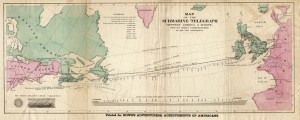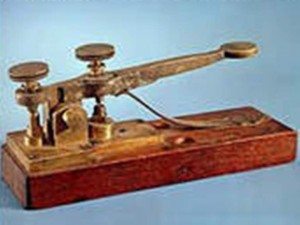 Communications have come a long way over the years. Still, most of us give little thought to how difficult it used to be in the not so distant past. Of course, letters were originally the only form of distant communications, and I suppose that some people, like my Uncle Bill, still think that is the best form of communication there ever was. These days, I would have to agree with them in many ways, but there are times when a letter is not quick enough. When the telegraph was invented in the 1830s and 1840s, it revolutionized communication. No longer did it take months to get an important message to family members. Prior to that time, a loved on might be dead for months before the family found out. I’m sure that in most cases, people still relied on letters for most things, so receiving an unexpected telegraph was probably a little scary.
Communications have come a long way over the years. Still, most of us give little thought to how difficult it used to be in the not so distant past. Of course, letters were originally the only form of distant communications, and I suppose that some people, like my Uncle Bill, still think that is the best form of communication there ever was. These days, I would have to agree with them in many ways, but there are times when a letter is not quick enough. When the telegraph was invented in the 1830s and 1840s, it revolutionized communication. No longer did it take months to get an important message to family members. Prior to that time, a loved on might be dead for months before the family found out. I’m sure that in most cases, people still relied on letters for most things, so receiving an unexpected telegraph was probably a little scary.
While telegraph made communications easier in our own country, trying to get an important message to someone from the homeland…not so much. Not until 1866, that is. Early attempts were made to lay  Transatlantic cable for the telegraph in the late 1850s, but those failed, and the confidence of the people was lost, taking with it investors willing to fork out the funds to undertake the next attempt. The first project began in 1854 and was completed in 1858. The cable functioned for only three weeks, but it was the first such project to yield practical results, so progress was being made. The first official telegram to pass between two continents was a letter of congratulation from Queen Victoria of the United Kingdom to the President of the United States James Buchanan on August 16, 1858. Signal quality quickly declined, slowing transmission to an almost unusable speed. The cable was destroyed the following month when Wildman Whitehouse applied excessive voltage to it while trying to achieve faster operation. The cable’s rapid failure undermined public and investor confidence and delayed efforts to restore a connection. A second attempt was undertaken in 1865 with much better materials, and following some setbacks, a connection was completed and put into service on July 28, 1866. This cable proved more durable.
Transatlantic cable for the telegraph in the late 1850s, but those failed, and the confidence of the people was lost, taking with it investors willing to fork out the funds to undertake the next attempt. The first project began in 1854 and was completed in 1858. The cable functioned for only three weeks, but it was the first such project to yield practical results, so progress was being made. The first official telegram to pass between two continents was a letter of congratulation from Queen Victoria of the United Kingdom to the President of the United States James Buchanan on August 16, 1858. Signal quality quickly declined, slowing transmission to an almost unusable speed. The cable was destroyed the following month when Wildman Whitehouse applied excessive voltage to it while trying to achieve faster operation. The cable’s rapid failure undermined public and investor confidence and delayed efforts to restore a connection. A second attempt was undertaken in 1865 with much better materials, and following some setbacks, a connection was completed and put into service on July 28, 1866. This cable proved more durable.
At that point, telegraph communications with the homeland of our nation’s immigrants became possible. While I’m sure it wasn’t inexpensive to send a telegraph…by the standards of the day, it did give the ability to keep in touch with family back home, and really, that was what it was all about. A letter from New York to England  took ten days…provided nothing happened to the ship it set sail on. And it still had to get from out west, if that was where you lived to the east coast. I don’t think a month was far off on this. But then how good was the mail service in Europe? It could still easily take another several weeks for the letter to arrive. Primitive communications for sure. Of course, very few people use telegraph these days. I believe it can still be used to wire money, but electronic transfers are much faster, and often free, so why use it? That is the funny thing about inventions. They are only good until the next big thing that is invented makes the old ones obsolete. That is what things like the cell phone, the internet, and electronic transfers have done to things like letter writing and telegraph.
took ten days…provided nothing happened to the ship it set sail on. And it still had to get from out west, if that was where you lived to the east coast. I don’t think a month was far off on this. But then how good was the mail service in Europe? It could still easily take another several weeks for the letter to arrive. Primitive communications for sure. Of course, very few people use telegraph these days. I believe it can still be used to wire money, but electronic transfers are much faster, and often free, so why use it? That is the funny thing about inventions. They are only good until the next big thing that is invented makes the old ones obsolete. That is what things like the cell phone, the internet, and electronic transfers have done to things like letter writing and telegraph.


One Response to Transatlantic Cable